
Social justice has long been a theme found throughout literature, with authors giving voice to the concerns of the day and finding the medium of storytelling as an effective way to argue a point directly to the reader. Oftentimes when a writer tackles a particularly pressing issue in their work, it is a reflection of their state of mind with regards to the issue at the time of writing. And though some works that tackle a social justice point head on can have the positive effect of stirring the conversation in it’s moment, their stories must also be able to stand on their own outside of that conversation. Some books that were considered progressive in their time have over the years been reexamined and critiqued as being relics of a era where those same values have either fallen out of favor or chaned completely. The novels of Uncle Tom’s Cabin and The Adventures of Huck Finn by Harriet Beecher Stowe and Mark Twain respectively were heralded as passionate arguments against slavery in their time, but their less enlightened depictions of black characters in the novels have led them to be heavily criticized based on the values of today. But if one novel manages to breakthrough the values of it’s day and can still resonate many years later with readers young and old with it’s message of racial equality, it’s that special piece of writing that stands as a true perennial masterpiece. Such is the case with Harper Lee’s To Kill a Mockingbird, a book whose legacy may be one of the most profound in all of American literature. First published in 1960, Mockingbird made it’s debut right at the height of the Civil Rights Movement in America. Though Civil Rights battles were ongoing throughout the history of America, it hit it’s apex immediately after the slaying of Emmett Till in 1955 and was brought to the mainstream with public figures like Dr. Martin Luther King Jr. leading the charge. And with Mockingbird’s direct and frank depiction of racial tensions in a small Southern town through the eyes of a young, impressionable girl named Scout, Harper Lee was able to connect readers of all races and backgrounds with the the call for Civil Rights in a way that still has the power to call for social justice over 60 years later.
Harper Lee is a unique icon in the world of American literature. She only ever published two novels in her entire lifetime, the second of which was a first draft of her most famous work that her estate chose to release publicly despite Lee’s own wishes (2015’s Go Set a Watchman). That’s not to say she wasn’t an active writer. She wrote hundreds of columns, essays and non-fiction pieces throughout her life, but To Kill a Mockingbird was her one and only fictional novel that she intended to publish. Most of her writing involved the life she knew growing up in Monroeville, Alabama, particularly with regards to the growing racial tensions she experienced there. Writing always seemed to be in her blood, and it worked out that her childhood friend in Monroeville also shared her interests. Living next door to her was a boy named Truman Parsons, who would later become known as Truman Capote, a prolific and influential literary icon in his own right. Capote made a splash in the literary world first with his successful run of columns in Harper’s Bazaar and the runaway bestseller Breakfast at Tiffany’s (1958). It was believed that in Capote’s first novel, Other Voices, Other Rooms (1948) that he based a character named Idabel on Harper Lee. Harper would return the gesture by basing a character named Dill on Capote in Mockingbird. Though she said that Mockingbird was not a direct autobiographical work, it is pretty clear that a lot of the canvas on which she draws her narrative is taken from her own childhood. At the center of the story is a young tomboy girl named Scout Finch who witnesses the trial of a black man falsely accused of rape where her father, Atticus Finch, argues for his defense in court. Though personal in nature, the story touches upon so many issues that resonated with readers that were themselves coming to terms with racial injustice in America. As a result, Harper Lee found herself becoming a perhaps unexpected but nevertheless essential contributor to the Civil Rights Movement that helped to end Jim Crow and Segregation laws in America.
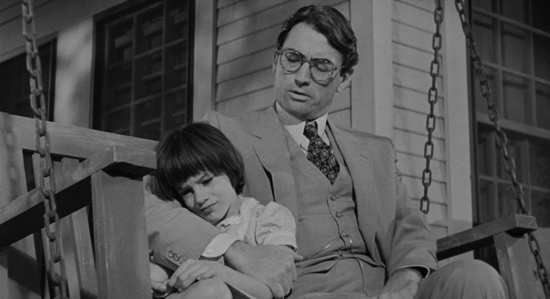
“You never really understand a person until you consider things from his point of view.”
Naturally, Hollywood took notice of the power of Lee’s novel, and immediately went to work on crafting a big screen adaptation. The rights to the novel were picked up immediately after publication by Universal Studios, though getting the movie on the screen wouldn’t be easy. For one thing, most other studios were reluctant to tackle issues regarding race at the time, given that they were afraid of losing the southern audience. That’s not to say that most of Hollywood was opposed to the Civil Rights Movement; it’s just that they viewed making a movie about racial injustice to be a financial risk that was better thought to be left untapped. So, many films that tackled racial injustice on the big screen tended to be smaller and low risk ventures, but that was about to change with Mockingbird. The novel was enormously popular with Hollywood elites, and many of them were campaigning hard to be a part of this upcoming film. Though Universal had a strong stable of acclaimed directors, the responsibility for adapting Lee’s novel would fall to Robert Mulligan, who up until that time was mostly a TV director. With his producing partner Alan J. Pakula, Mulligan sought to create a very down to earth adaptation of Lee’s writing, free from the typical melodrama of most socially conscious Hollywood films. The casting of the roles was also a particularly important part of the development of the film. The characters of Scout and her brother Jem would go to newcomers Mary Badham and Philip Alford, both authentically from Alabama. The crucial role Atticus would pass through the hands of many Hollywood leading men at the time, including Universal’s top box office star at the time, Rock Hudson, who campaigned hard for the role. Ultimately, the role was given to Gregory Peck, who said yes after having read the novel in a single sitting the night before. In both it’s approach and it’s execution, Universal Pictures’ adaptation of To Kill a Mockingbird was intent on bringing to the screen the essence of Harper Lee’s pivotal novel, and for the most part, it was a successful execution.
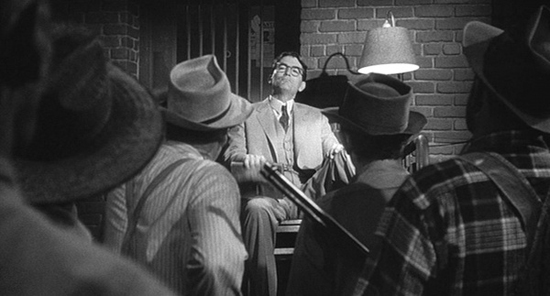
“Courage is not a man with a gun in his hand. It’s knowing you’re licked before you begin but you begin anyway and you see it through no matter what.”
Upon both reading the novel and watching the movie, it is pretty astounding how well it translated. Though some of the flavor of the setting in Harper’s writing gets lost in the translation, the overall narrative is there in tact. We are told the story, like in the novel, through the eyes of Scout, though the movie adds the factor of it being a recollection several years after the fact by an adult Scout (voiced in narration by an uncredited Kim Stanley). And with this perspective, the movie is able to tap into a sense of nostalgia that informs the tone of the movie. Though the novel and the movie indeed are about racial injustice in the South, it is also a story about innocence lost and the effect that moments of distress and trauma have on children. For much of the story, Scout learns more and more about the struggle of racial justice, and how truly critical it is for justice to be upheld. She watches as her father puts his own reputation and even safety on the line in their quiet little town for the sole purpose of showing that everyone, regardless of race, should be treated fairly under the law. A particularly potent moment from the book that made it into the movie involves Atticus holding back a lynch mob from taking his client out of prison and enacting their own warped sense of “Southern Justice.” Only when Scout and Jem unexpectedly show up to meet Atticus in the middle of this tense situation does the mob disperse. Knowing the history of lynchings in the South, this scene carries some very ominous overtones, and it becomes a pivotal teaching moment for Scout as well. Having faced harassments at school because of her father’s case, and how her father remains undeterred in the face of a mob, she learns that social justice is a struggle that requires a strong sense of moral fortitude, and it emboldens her to take the issue more seriously. Scout’s journey, from being ambivalent towards social issues towards becoming more compassionate and serious with regards to racial injustice is at the core of why Harper Lee’s novel is such a crucial benchmark in the Civil Rights movement. It’s a call for readers to wake up and see more clearly the struggles that exist within their own neighborhood and not be deterred by the power structures that allow for those barriers to endure.
One of the most remarkable aspects of the film’s production is how well it brings the audience into the world of Harper Lee’s writing. The fictional town of Mycomb, modeled obviously by Lee’s own hometown of Monroeville, feels so authentic within the movie, that anyone might swear that it was a real place in rural Alabama. But in fact, the entire movie was shot right on the Universal Studios lot in the heart of Hollywood, California. Everything from the town square to Finch’s quaint little neighborhood was fabricated from scratch. To fit the Southern Gothic nature of Lee’s novel, every element of the setting had to feel lived in, and the production design team, led by the legendary Henry Bumstead, put so much effort to recreate a Southern setting right in the middle of Universal Studios. Most of the sets are gone today, but the town square remains a fixture on the backlot to this day. It may be familiar to Back to the Future (1985) fans, as the courthouse façade was repurposed many years later to become the iconic Clock Tower from that movie. The interiors were also intricately detailed to reflect the kind of town that Harper Lee was familiar with. The pivotal courtroom set, where a big chunk of the movie takes place, was modeled after a real one in Monroeville, which is used to this day as a staging venue for theatrical adaptations of the novel and many other plays as well. Much of the reason why Universal went so far out of it’s way to build the town within the novel instead of shooting on location mostly had to do with the fact that much of Lee’s childhood home had been modernized over the years, and no longer retained that Depression Era aesthetic that she described in the book. It’s probably the main reason, but it might have also shielded Universal from any local resistance from the Southerners who objected to the message from the novel. In any sense, the best aspect of the movie is that it stays true to the novel’s sense of time and place, and it drives home for the audience a sense of authenticity that often was rarely found in most movie depictions of the South.
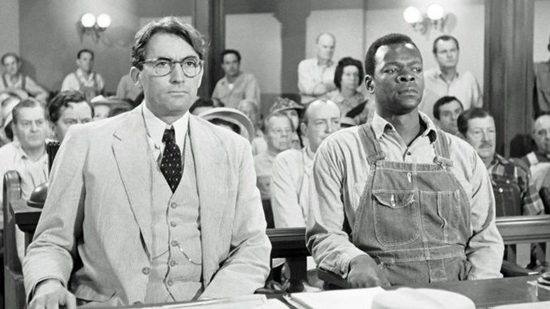
“Our courts have our faults, as does any human institution, but in this country our courts are the great levelers, and in our courts all men are created equal.”
But apart from the setting, what most people remember from the movie is the character of Atticus Finch himself. Harper modeled the character mostly on her own father Amasa Coleman Lee, an attorney who also was in the business of taking on black clients who were being persecuted by the Jim Crow system of justice in the South. Though the elder Lee was not quite as progressive as the Atticus depicted in the novel and film, he did become an advocate for racial equality in his later life, and was proud of Harper’s effective advocacy for such issues. No doubt the stoic, unbending strength of the character appealed greatly to a long time supporter of civil rights like Gregory Peck. Though Peck had been around for years in Hollywood, the actor had struggled to define his place as a leading man. Stuck in mostly war films and westerns, with an occasional romantic comedy thrown in (Roman Holiday), Gregory wanted desperately to have that role that really showed off his strengths as a dramatic actor and also embody the progressive politics that he held up so seriously. In Atticus, he found that role that would indeed define his career and turn him into an icon. It’s hard to imagine anyone but Peck in the role. With his towering frame and booming voice, Peck’s Atticus is the very definition of stoic strength. But Peck uses his acting talents beautifully in the role, especially during those courtroom scenes. His delivery of the defense for the accused, Tom Robinson (a fantastic Brock Peters), is dignified and with conviction, and is one of the most inspirational arguments for the definition of true justice ever put on screen. Peck’s incredible performance is also matched by the authenticity of Mary Badham’s Scout, who is honestly the living embodiment of her literary counterpart. If Atticus is the movie’s moral backbone, than Scout is it’s beating heart, and both are brought to perfect life by the actors portraying them. The supporting players also feel authentic too, especially considering that some of them are acting outside of their comfort zone portraying some pretty vile racist characters. But considering the importance of the story’s message, it’s a testament that everyone aimed to be as authentic as possible.
Since it’s debut, both on the page and on the screen, To Kill a Mockingbird has become pretty much an essential piece of media for generations. It was especially an effective tool in classrooms to teach students about racial history in America. I myself remember having to read the novel in school and I was introduced to the movie for the first time in the same way. But, like many other pieces of literature that has been examined and re-examined over the years, the novel and movie have faced criticisms for it’s portrayal with regards to racial issues. One of the most common criticisms is that it speaks about racial justice from a very white perspective, which some have claimed is patronizing to Black Americans. In addition, it has been said that Atticus Finch is one of the clearest examples of the “White Savior” trope ever used in literature; where the focus of the story becomes less about the people who are victims of racial bigotry and more about the white people who come to their aid with far less resistance in their way. It is a problem that Hollywood has had over the years, with well intentioned social justice films being made that unfortunately turn into self-serving vanity projects in the long run. There are elements in To Kill a Mockingbird that do unfortunately fall into this trope, particularly surrounding the character of Atticus. Atticus is very much lionized in the novel and the film, and that is reflected in moments that we see with the black citizens in the community showing reverence for the man. A memorable scene from the movie, where all the black audience members in the courtroom stand up for Atticus when he leaves the floor after the trial has ended could easily fall into that kind of trope. However, given the context of the scene in the movie, and the inspiration from which Lee drew upon, the moment feels less exploitive and more genuinely loving. Atticus stood up for one of their own, so they will stand up for him (symbolically at least). It’s about finding the common ground on which all races can strive to fight for, and that’s where I think To Kill a Mockingbird rises above those tropes. I honestly am glad that I was exposed to a movie and novel like Mockingbird at such a young age, because it informed me why issues like this matter and why that moment of shared reverence for one another in that courtroom is such an ideal to strive for in our society.
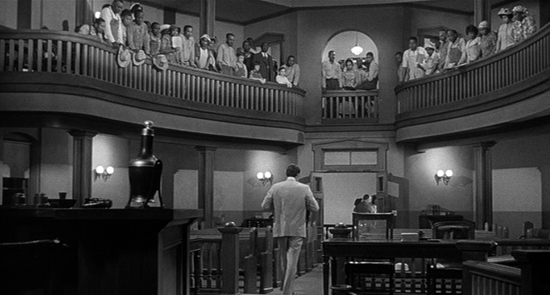
“Miss Jean Louise, stand up. You’re father’s passing.”
Like the novel it was based on, the movie To Kill a Mockingbird was a sensational success both critically and with audiences. It was nominated for the Best Picture Oscar, but didn’t win (which is hard for me to argue against since the movie that won is my all time favorite film, Lawrence of Arabia). Still, Gregory Peck walked away with the Best Actor award, which is probably one of the most well deserved in the history of the honor. Atticus Finch, to this day is still celebrated as an idealized crusader for social justice that many activists today aspire to be like. And like Scout, upon experiencing this story and witnessing it unfold, we have our own eyes upon to what role we must play in making the world a more just place. It is reflected in Scout ultimately opening her heart out to another outsider in the story, the recluse Boo Radley (Robert Duvall in his screen debut), after he had saved her and her brother Jem from an attack by a vengeful racist thug. Like Scout, the events of the story make us open our heart to those who fall unfairly outside the justice system today, and it calls upon us to reconsider our own place in the world and what we must do to seek justice for those that don’t usually get it. That is in essence what Harper Lee wanted us to learn in her novel, and probably more than any other American novel of the 20th century, it shaped the conversation on racial issues across the whole mainstream, and helped push the Civil Rights movement further than ever before. Harper won a well deserved Pulitzer for her work and in the years since the novel has only grown more in esteem. Even most Southerners hold it up as a work of literary genius. Still, the reason why both the book and the movie endure to this day is that it gives a strong human connection to a universal theme of social justice. Even 60 years after it’s original publication, the themes of the novel still resonate, as racial injustice is a reoccurring problem that we still grapple with; the recent killings of George Floyd and Breonna Taylor at the hands of police officers last year, among far too many others, being a perfect example. Despite some legit criticisms of it’s handling of racial justice in it’s narrative, To Kill a Mockingbird is a story just as potent today as it was when it was first published. With Harper Lee’s graceful writing, and easily identifiable characters, it’s a story that appeals to our better angels and reminds us that racial justice and equality need help in the world and that we must recognize it and fight for it.
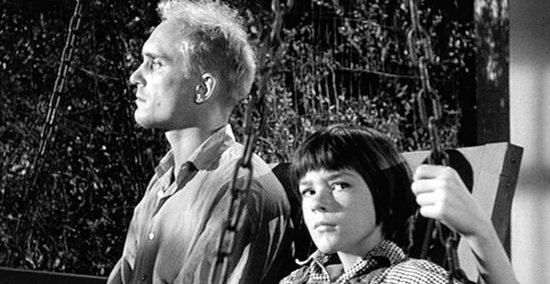
“He turned out the light and went into Jem’s room. He would be there all night, and he would be there when Jem waked up in the morning.”